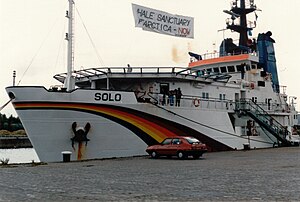
Australian Maritime Safety Authority (AMSA) is an Australian statutory authority responsible for the regulation and safety oversight of Australia's shipping fleet and management of Australia's international maritime obligations. The authority has jurisdiction over Australia's exclusive economic zone which covers an area of 11,000,000 square kilometres (4,200,000 sq mi). AMSA maintains Australia's shipping registries: the general and the international shipping registers.
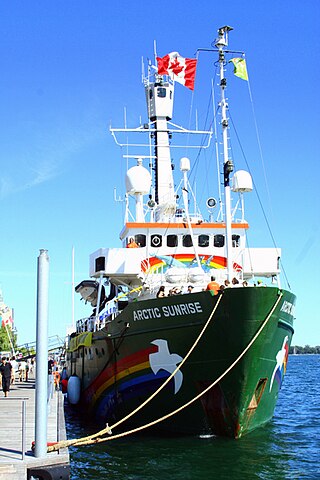
Arctic Sunrise is an ice-strengthened vessel operated by Greenpeace. The vessel was built in Norway in 1975 and has a gross tonnage of 949, a length of 50.5 metres (166 ft) and a maximum speed of 13 knots. She is classified by Det Norske Veritas as a "1A1 icebreaker". The ship is powered by a single MaK marine diesel engine.

MV Esperanza was a ship operated by Greenpeace. Previous to being a Greenpeace ship it was a fire-fighting vessel owned by the Soviet Navy, built in 1984. It was recommissioned in 2000 and relaunched in 2002 after being named Esperanza by visitors to the Greenpeace website. It had undergone a major refit by Greenpeace to make it more environmentally friendly. A new helicopter deck and boat cranes were also added. The ship was powered by two Sulzer V12 marine diesel engines.

The Nisshin Maru (日新丸) was the primary vessel of the Japanese whaling fleet and was the world's only whaler factory ship. It was the research base ship for the Institute of Cetacean Research for 2002 to 2007. It had a tonnage of 8,145 GT and is the largest member and flagship of the five-ship whaling fleet, headed by leader Shigetoshi Nishiwaki. The ship was based in Japan in Shimonoseki harbor and was owned by Tokyo-based Kyodo Senpaku, which is a subsidiary of the Institute of Cetacean Research.

The Holland-class ocean-going patrol vessels are a class of four ocean-going patrol vessels constructed for the Royal Netherlands Navy. They are designed to fulfill patrol and intervention tasks against lightly armed opponents, such as pirates and smugglers, but have much higher level electronic and radar surveillance capabilities which are used for military stabilization and security roles, short of outright war. Without sonar or long range weapons, they utilize the surveillance capabilities of the Thales integrated mast, which integrates communication systems and two four-faced phased arrays for air and surface search.

USS Kittiwake (ASR-13) was a United States Navy Chanticleer-class submarine rescue vessel in commission from 1946 to 1994.

USS Enhance (AM-437/MSO-437) was an Aggressive-class minesweeper acquired by the U.S. Navy for the task of removing mines that had been placed in the water to prevent the safe passage of ships.

The MV Sirius was a Greenpeace ship named after the star Sirius. The Sirius was built with modern specifications at the Boele shipyard in the Netherlands in 1950 as one of 7 pilot vessels. The ship, originally owned by the Royal Dutch Navy, was sold to Greenpeace during 1981 while in dry dock. The ship was refitted, repaired, and repainted. It took ten weeks to paint her. The ship's colour scheme was soon changed to a green hull and rainbow colours and a white dove of peace with an olive branch was painted on the bow. Sirius was refitted with more modern navigation systems, communication equipment, lifeboats, and rafts. The pantries were turned into outdoor engine rooms and the mess room became a storage room.
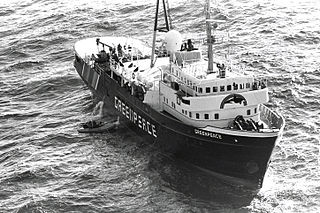
The MV Greenpeace was a Greenpeace ship built in 1959 as an oceangoing tug/salvage vessel. She was purchased by Greenpeace in 1985 from the Maryland Pilotage Company, the vessel then being named MV Maryland, and transferred back to the Netherlands to be refitted with modern equipment before being recommissioned. She took over from the first Rainbow Warrior, which had been sunk in 1985 by French commandos. In 2001 she was replaced by the MV Esperanza.

Rainbow Warrior was a Greenpeace ship involved in campaigns against whaling, seal hunting, nuclear testing and nuclear waste dumping during the late 1970s and early 1980s. The Direction Générale de la Sécurité Extérieure bombed Rainbow Warrior in the Port of Auckland, New Zealand on 10 July 1985, sinking the ship and killing photographer Fernando Pereira.

Rainbow Warrior was a three-masted schooner most notable for service with the environmental protection organization Greenpeace. She was built to replace the original Rainbow Warrior that the French intelligence service (DGSE) bombed in 1985 in the Port of Auckland, New Zealand, which sank the ship and killed photographer Fernando Pereira.

BRP Miguel Malvar (PS-19) is the lead ship of the Miguel Malvar class of corvettes of the Philippine Navy. She was originally built as USS Brattleboro PCE(R)-852, a PCE(R)-848-class rescue patrol craft escort for the United States Navy during World War II. In 1966 she was transferred to South Vietnam for service in the Republic of Vietnam Navy as RVNS Ngọc Hồi (HQ-12). She was acquired by the Philippine Navy in April 1976 and later on commissioned as Miguel Malvar after Miguel Malvar y Carpio. The ship is in active service. Along with other World War II-era ships of the Philippine Navy, Miguel Malvar is one of the oldest active fighting ships in the world today.

An emergency tow vessel, also called emergency towing vessel, (ETV) is a multi purpose boat used by state authorities to tow disabled vessels on high seas in order to prevent dangers to man and environment. The disabled vessel is either towed to a safe haven or kept in place against wind and current until commercial assistance by tug boats has arrived on site or until it has been repaired to the extent of being able to manoeuvre on its own. The need for ETVs as a preventive measure has arisen since the number of available commercial salvage tugs was reduced while potential dangers from individual vessels have increased. E.g. Spain has fourteen, Turkey has eleven, Germany operates eight, Norway has seven, France has five, Sweden three and the Netherlands, Poland, South Africa, Iceland and Finland each have one official emergency tug boat. Australia also operates emergency response vessels. The United Kingdom's four strong ETV fleet was to be disbanded in September 2011 due to budget cuts but the two vessels operating in Scottish waters received an extension of contract until the end of 2011.

HDMS Ejnar Mikkelsen is a Royal Danish Navy patrol vessel. Launched in November 2007, she is the second vessel of the Knud Rasmussen class. The normal patrol area of the Ejnar Mikkelsen, and her sister ships, will be the waters around Greenland.
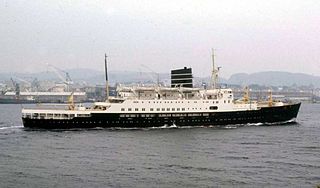
TS Leda was operated by Bergen Line between Britain and Norway as a North Sea ferry for over 20 years from 1953. She was rebuilt in 1981 as a cruise liner and later became an accommodation vessel at a penal colony for terrorists and members of the Mafia. In 2002, whilst being broken up, she was boarded by Greenpeace campaigners protesting about conditions in the shipbreaking industry.

USNS Powhatan (T-ATF-166) was the lead ship of the United States Navy Powhatan-class fleet ocean tugboats. She was in service with the U.S. Navy from 1979 to 1999, and then was leased to a private towing and salvage company. At the end of the lease in 2008, the ship was sold to the Turkish Navy which recommissioned her as TCG Inebolu.

Rainbow Warrior is a purpose-built motor-assisted sailing yacht owned and operated by Greenpeace and intended for use in their activities such as environmental protests and scientific excursions. She was christened on October 14, 2011, and has replaced Rainbow Warrior II after further upgrades and maintenance of the older ship had been shown to be impractical.

The United Kingdom's emergency towing vessel fleet were a maintained fleet of emergency tow vessels (ETV) from 1993 through 2011. The vessels were privately owned and operated for Her Majesty's Coastguard. Four vessels were stationed around the UK coastline, while a fifth was held in reserve.

HNLMS Van Nes was a Admiralen-class destroyer of the Royal Netherlands Navy, named after the 17th century Dutch admiral Jan Jansse van Nes. She served during World War II.
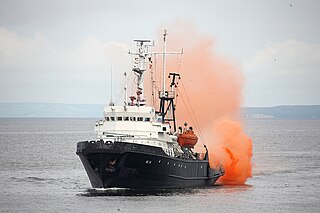
The Sorum class, Soviet designation Project 745, is a series of seagoing tugs built for the Soviet Navy and KGB Border Troops, and later operated by the Russian Navy and FSB Border Service.
